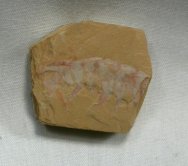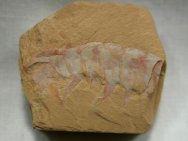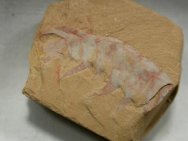Anomalocaris
saron
Phylum Uncertain,
Anomalocarididae
Geological
Time: Early Cambrian (~525 million years ago)
Size (25.4mm=1
inch): 24 mm long on a 25 mm by 23 mm matrix
Fossil
Site: Chengjiang Maotianshan Shales, Quiongzhusi Section, Yu’anshan
Member, Heilinpu Formation, Ercaicun, Haikou County, Kunming, Yunnan Province,
China
| 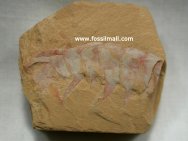 Description:
The discovery of the Chengjiang Biota by Hou Xian-guang in 1984
opened a window onto a remarkable array of lifeforms from what is
termed the Cambrian Explosion. The diversity of soft-tissue fossils
is astonishing: algae, medusiforms, sponges, priapulids, annelid-like
worms, echinoderms, arthropods (including trilobites), hemichordates,
chordates, and the first agnathan fish make up just a small fraction
of the total. Numerous problematic forms are known as well, some
of which may have represented failed attempts at diversity that
did not persist to the present day. This is thetip of the grasping
arm of the “Terror Of The Cambrian”, Description:
The discovery of the Chengjiang Biota by Hou Xian-guang in 1984
opened a window onto a remarkable array of lifeforms from what is
termed the Cambrian Explosion. The diversity of soft-tissue fossils
is astonishing: algae, medusiforms, sponges, priapulids, annelid-like
worms, echinoderms, arthropods (including trilobites), hemichordates,
chordates, and the first agnathan fish make up just a small fraction
of the total. Numerous problematic forms are known as well, some
of which may have represented failed attempts at diversity that
did not persist to the present day. This is thetip of the grasping
arm of the “Terror Of The Cambrian”, 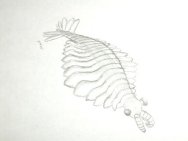 Anomalocaris
saron, seen here as a part/counterpart pair. The members of this
group of enigmatic creatures are known from Asia, Australia, Europe,
and North America, and are thought by many to be closely allied
with the Arthropda, as position not held by all researchers. As
of the publication of Hou’s book in 2004, some 20 examples
were known, most being grasping arms like this one. The spiniferous
grasping appendages are strongly suggestive of its carnivorous habits;
some trilobites from Utah bear evidence of bite marks that have
been attributed to Anaomalocaris. Known only from the Chengjiang
biota, this species is closely related to A. canadensis, the type
species, from the younger Burgess Shale. The genus derives its name
from “anomalous shrimp” which was what the describer
thought the appendage was. Anomalocaris
saron, seen here as a part/counterpart pair. The members of this
group of enigmatic creatures are known from Asia, Australia, Europe,
and North America, and are thought by many to be closely allied
with the Arthropda, as position not held by all researchers. As
of the publication of Hou’s book in 2004, some 20 examples
were known, most being grasping arms like this one. The spiniferous
grasping appendages are strongly suggestive of its carnivorous habits;
some trilobites from Utah bear evidence of bite marks that have
been attributed to Anaomalocaris. Known only from the Chengjiang
biota, this species is closely related to A. canadensis, the type
species, from the younger Burgess Shale. The genus derives its name
from “anomalous shrimp” which was what the describer
thought the appendage was.
|
|


